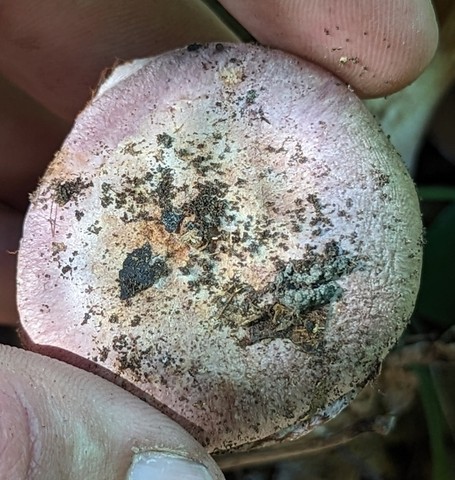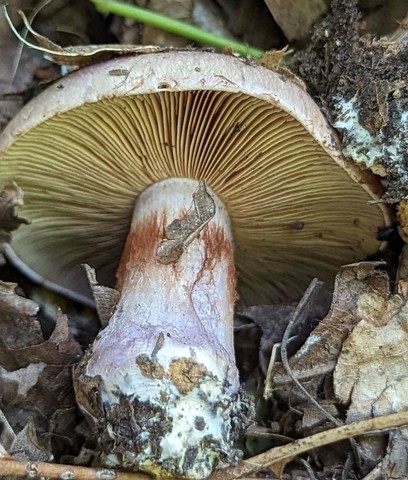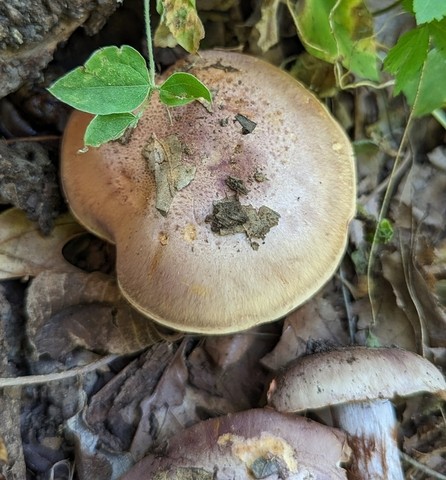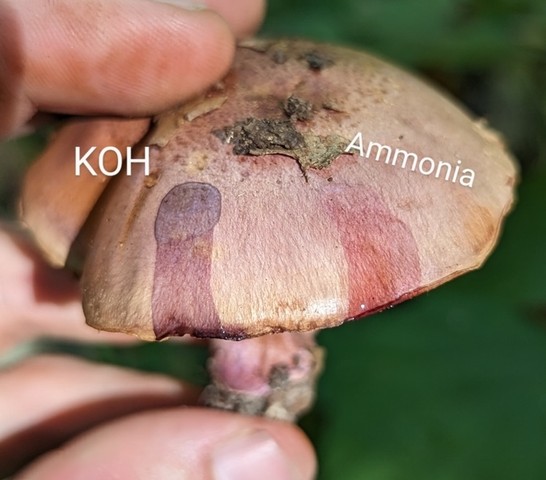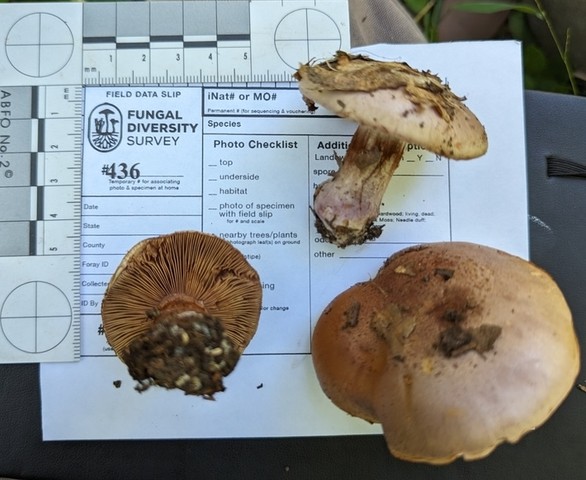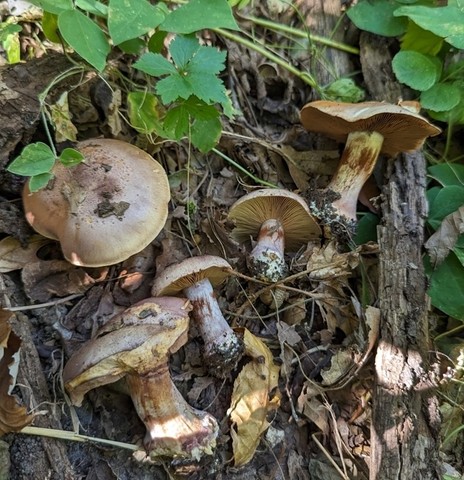Calonarius caesiofulvus
Life > Fungi > Basidiomycota > Agaricomycotina > Agaricomycetes > Agaricomycetidae > Agaricales > Agaricineae > Cortinariaceae > Calonarius > Subgenus.Fulvi > Section.Fulvi
Description
Calonarius caesiofulvus is a mycorrhizal mushroom that forms a symbiotic association with trees in the Fagaceae (oaks, beech, etc.). This mushroom was recently described in 2024 (Liu, et al., 2024) and has so far been reported only from Gainesville, Florida, and Indian Cave State Park (ICSP) in Nebraska. It has been found fruiting at ICSP in late September, presumably associating with Oak trees. The Latin name refers to the changing colors of the fruiting bodies as they mature: caesi- meaning bluish-gray and fulv- meaning reddish-yellow or tawny (Borror, 1988).
Cap: hemisphereical when young becoming broadly convex to nearly flat with age. The surface texture is innately fibrillose (covered with fine, adhering fibers), viscid (slimy or tacky), and pale grayish purple when young, turning brown with a yellow margin as it matures. The flesh (context) is white to yellow.
Gills: crowded and yellow.
Stem: dry, with a cortina (a cobweb-like partial veil) that leaves a brown annular zone from spore deposits. The base is marginate (featuring a bulb with an angular ridge marking the attachment of the universal veil) and often bears remnants of a bluish-purple universal veil. The flesh is yellow, especially towards the base.
Basal mycelium: white to yellow.
Odor and taste: not distinctive.
Observations
September 28th, 2023 Indian Cave State Park
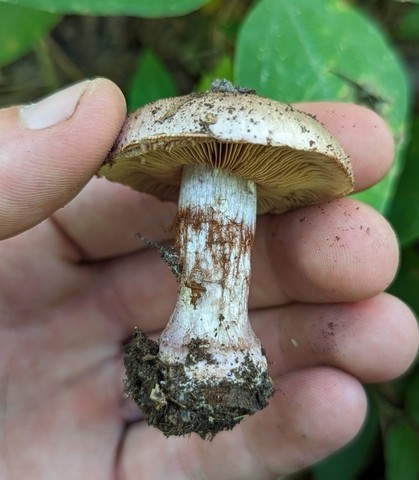
#436
- Growing in mixed oak/hickory woodland ridge.
- Nearby Trees: Black Oak, Elm, Red Mulberry, Bitternut Hickory, Chinkapin Oak, Black Walnut, and Northern Red Oak.
Additional Info
- Smell: not distinctive
- Taste: not distinctive
- KOH: light purple on pileipellis.
- Ammonia: light pink on pileipellis.
GTCGTAACAAGGTTTCCGTAGGTGAACCTGCGGAAGGATCATTATTGAAATAAACTTGATAAGTTGTTGCTGGTTCTCTAGGGAGCATGTGCACGCTTGTCATCTTTGTATCTCCACCTGTGCATCTTTTGTAGACCCTTGGGTATCTCTCTGATTGCTATTTTAGCATTTAGGATTGAGGATTGACTTTTCTGTCTTTCCTTACATTTCCAGGTCTATGTTTTCTTCAAATACTCTAATGTATGTTTATAGAATGTAATAAATGGGCCTTTGTGCCTATAAATTGTTACAACTTTCAGCAACGGATCTCTTGGCTCTCGCATCGATGAAGAACGCAGCGAAATGCGATAAGTAATGTGAATTGCAGAATTCAGTGAATCATCGAATTTTTGAACGCACCTTGCGCTCCTTGGTATTCCGAGGAGCATGCCTGTTTGAGTGTCATTAATATCATCAACTTTTTTTGGTTGGATGTGGGTTTGCTGGCCGCTTTTGAGGTCAGCTCTCCTTAAATGCATTAGCGGGACAACTTGTTGCCAAACGCTCATTAGTGTGATAATTATCTACGCTATTGACGTGAAGCAGGTTCAGCTTCTAATAGTCCATTGACTTGGACAAATTTATTAATGTGACCTCAAATCAGGTAGGATTACCCGCTGAACTTView MycoMap DNA Results
References
Donald J. Borror. (1988). Dictionary of Word Roots and Combining Forms Compiled from the Greek, Latin, and Other Languages. Mayfield Publishing Company. https://www.penguinprof.com/uploads/8/4/3/1/8431323/dictionary_of_word_roots_and_combining_forms.pdf
Liimatainen, K., Kim, J. T., Pokorny, L., Kirk, P. M., & Niskanen, T. (2022). Taming the beast: A revised classification of Cortinariaceae based on genomic data. Fungal Diversity, 112(1), 89–170. https://doi.org/10.1007/s13225-022-00499-9
Liu, S.-L., Wang, X.-W., Li, G.-J., Deng, C.-Y., Rossi, W., Leonardi, M., Liimatainen, K., Tapio Kekki, Niskanen, T., Smith, M. E., Ammirati, J., Dimitar Bojantchev, Abdel-Wahab, M. A., Zhang, M., Tian, E., Lu, Y.-Z., Zhang, J.-Y., Ma, J., Dutta, A. K., & Acharya, K. (2024). Fungal diversity notes 1717–1817: taxonomic and phylogenetic contributions on genera and species of fungal taxa. Fungal Diversity, 124(1), 1–216. https://doi.org/10.1007/s13225-023-00529-0
Snell, W. H., & Dick, E. A. (1971). A Glossary of Mycology. Harvard University Press.
Created December 15, 2025 at 10:41 AM
